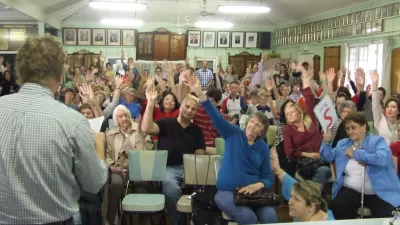Discover how urban planners can use social media to enhance citizen engagement, featuring strategies for interactive communication and community involvement in urban development projects.

Engaging with citizens is pivotal to understanding future designs that mesh with their wants and needs. It forges a more inclusive and sustainable community while promoting interactivity and technological innovations. How do civic engagement and social media relate to changing in the urban planning sector?
How urban planners use social media
Strategic planning is the pinnacle of social media execution. Even though urban planners are not lifestyle influencers, they should consider their presence and relationship with their audience thoughtfully. If cities want authentic engagement and participation from citizens, urban planners use social channels in these ways.
First is engagement campaigns. Urban designers are likely selling ideas and projects more than products. Collecting data via surveys, polls, and interactive video content is the perfect way to gather passionate responses from volunteers who care. Workers know those following these outlets respond because they are invested in their community. Targeted, regional campaigns are pivotal to decision-making for planners.
Virtual events are another reason social media is a powerhouse for city workers. Imagine a digital city council meeting to discuss urban design developments or challenges. People could vote, participate in Q&As, and speak at a virtual podium to address concerns. This provides accessible engagement opportunities.
Urban planners must use social media for its best application — community-driven idea generation. One crowdsourced idea could spark a park’s creation or investment into renewable energy. Residents know their neighborhoods the best, so they have insights urban planners may not. Social media gathers people while giving them validation that their thoughts matter to the city.
When social media was effective
What real-life circumstances prove urban planners operate more creatively and efficiently with the help of social media? One study aimed to expand the narrow realm of digital urban research. Most focused on geotags, textual social media and subjective data. However, this review focused on using social media images to inform urban planners how people experienced their cities. It brought an ethnographic point of view to a stereotypically data-driven field.
Over 39,000 Instagram posts from Denmark users revealed behaviors of residents during the COVID-19 pandemic in 2020. The #BareDenmark campaign revealed how people gravitated toward natural settings like beaches and lighthouses. Attachments to these regions rose, which initiated conversations about green space equality across Copenhagen.
Another study in Beijing, China, identified how much urban and virtual space perception influences public opinion. The planners used virtual questionnaires to determine what mattered most to residents. Here are the findings:
- The space’s attractiveness is the most important factor.
- Safety was at the bottom of the list.
- People enjoyed places with vibrant, active social atmospheres.
This information will help designers craft people-first spaces that reflect citizens’ interests and priorities.
How to leverage social media like a pro
Channel moderators should post consistently via an editorial calendar on their most lucrative platforms. It is the most reliable way to stay relevant logistically and algorithmically. Communities will appreciate it, especially when urban development projects impact them.
Timely, transparent updates about traffic pattern changes make citizens feel cared for if it impacts their daily commute. If there is an anticipated urban agriculture project in progress, reminding citizens of relevant dates helps people stay in touch with related city meetings.
Isolated posts are not enough to start meaningful conversations. Respond to comments and direct messages to ensure residents feel part of urban planning solutions. This creates a two-way communication expectation, leading to potential activism or inspiring the next generation of urban planning students.
Keeping dialogue open, active and inclusive will solidify citizen engagement for the long term, even if new residents move into the area. Regular responses let people know their suggestions and concerns fall on attentive ears.
Here are a final few tips for solidifying a quality social media presence as an urban planner:
- Use hashtags to find microcommunities and expand reach.
- Review analytics and feedback on a schedule.
- Prioritize inclusive language, captions and visual content.
- Remain open-minded to adapting new strategies as trends change.
Social media planning is urban planning
Social media is ever-evolving — like urban areas. The two connect residents and planners in a single, digital space. It could inspire novel ideas and push projects to completion, and those adopting it for citizen engagement could witness a culture shift in their towns.

Study: Maui’s Plan to Convert Vacation Rentals to Long-Term Housing Could Cause Nearly $1 Billion Economic Loss
The plan would reduce visitor accommodation by 25,% resulting in 1,900 jobs lost.

North Texas Transit Leaders Tout Benefits of TOD for Growing Region
At a summit focused on transit-oriented development, policymakers discussed how North Texas’ expanded light rail system can serve as a tool for economic growth.

Why Should We Subsidize Public Transportation?
Many public transit agencies face financial stress due to rising costs, declining fare revenue, and declining subsidies. Transit advocates must provide a strong business case for increasing public transit funding.

How to Make US Trains Faster
Changes to boarding platforms and a switch to electric trains could improve U.S. passenger rail service without the added cost of high-speed rail.

Columbia’s Revitalized ‘Loop’ Is a Hub for Local Entrepreneurs
A focus on small businesses is helping a commercial corridor in Columbia, Missouri thrive.

Invasive Insect Threatens Minnesota’s Ash Forests
The Emerald Ash Borer is a rapidly spreading invasive pest threatening Minnesota’s ash trees, and homeowners are encouraged to plant diverse replacement species, avoid moving ash firewood, and monitor for signs of infestation.
Urban Design for Planners 1: Software Tools
This six-course series explores essential urban design concepts using open source software and equips planners with the tools they need to participate fully in the urban design process.
Planning for Universal Design
Learn the tools for implementing Universal Design in planning regulations.
Ascent Environmental
Borough of Carlisle
Institute for Housing and Urban Development Studies (IHS)
City of Grandview
Harvard GSD Executive Education
Toledo-Lucas County Plan Commissions
Salt Lake City
NYU Wagner Graduate School of Public Service






























